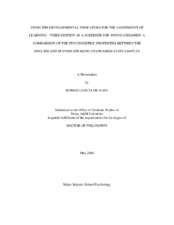| dc.description.abstract | Demographic data show that public schools are faced with meeting the academic
demands of a population that is becoming more ethnically and linguistically diverse.
Preventative steps can give schools the opportunity to address the needs of its students
before systemic inefficiencies can negatively impact student academic outcomes. For this
reason, it is important that school psychologists remain vigilant regarding the most
efficient and cost effective means to identify problems early. Since Spanish is the most
prevalent language of children in the schools other than English, there is a need for
school psychologists to find screening instruments that are specifically designed to
convey an accurate representation of the abilities of this population. One screening
instrument that has been posited as effective in assessing both English and Spanish-speakers
is the Developmental Indicators for the Assessment of Learning - Third Edition
(DIAL-3). The purpose of this study is to expand the work of the DIAL-3 authors to
include more detailed information regarding its reliability and validity for the Spanish speaking sample. This study was conducted using the data from the standardization
samples of both the English and the Spanish versions of the DIAL-3.
Given the nature of the instrument, the obtained reliability estimates, computed
using Cronbach's (alpha), fell within the expected range. Reliability estimate comparisons
between English and Spanish-speaking samples were not statistically significant with the
exception of the reliability comparisons in two domains of the DIAL-3 in the 3 years 0
months to 3 years 5 months age range. Results from additional statistical analyses
conducted for this study support the discriminant validity of the test. However, a
moderate linear relationship was found between the Concepts and Language Domains (r
= .61, p <.01). In addition, a series of confirmatory factor analyses were conducted in
order to determine the invariance of the variance-covariance matrices between the
English and Spanish standardization samples. The four fit indices examined (GFI, CFI,
NFI, and RMSEA) for the constrained model were within the acceptable limits. These
results indicate that the three-factor model originally proposed by the test authors is
adequate for both the English and Spanish versions of the DIAL-3. | en |


